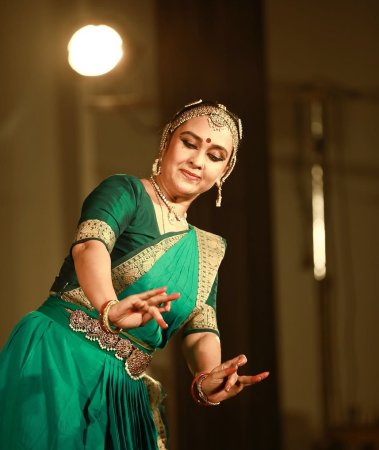
|   |

|   |
Samakhya by Rajashree Warrier at Cognitopia 2025 - AM Hari Shankar e-mail: hshankar252@gmail.com Photos: Sujith Sudheesh March 11, 2025 The imperativeness of creating a sense of art appreciation is vested upon the educational establishments. In the current scenario, where the College fests revolve around the pompous band shows and celebrity presence, Government College for Women, Vazhuthacaud, Thiruvananthapuram, stood exemplar by organizing a three-day Multidisciplinary Academic Fest - "Cognitopia 2025", to promote awareness about diverse research initiatives across various fields, including Science, Arts, Commerce, and Languages for their quasquicentennial celebrations. Among the myriads of events, an exceptional one was an inspiring Bharatanatyam performance by Dr. Rajashree Warrier on the second day.  Rajashree Warrier Rajashree, known for her experimentations in Bharatanatyam, commenced with an invocation to Lord Ganesha, followed by Sharada Alarippu set in Chaturasra Jaathi eka talam. It stood exquisite due to its atypical approach, encompassing complex patterns and distinctive postures. This novel choreography evoked a sense of an arriving autumn and a pristine ambience which set a good head start. The veena rendition in between the jathis added much subtlety. Rajashree explored the contrasting nritta patterns and put forth her varied ideas to draw different scapes of autumn. Her exploration in the adavus was a delight to watch. An Annamacharya Sringara Sankeertanam, "Komma tana mutyaala" in Yadukula Kambhoji ragam and khanda chapu talam was a testimony of Rajashree's creative ability. This krithi is about the separation of Lord Venkateshwara and his consort Padmavati, due to a vow taken by him to see her only after repaying the loan taken for his marriage from Kubera. The episode starts with the priest at Tirupati removing all the alankarams (ornament decorations) of the Lord. The lokadharmi abhinaya of Venkateshwara Swami - relaxing after the priest retires - due to the heavy garlands and anklets, embodying a realistic and natural response, was very expressive. The scenes of Alamelu Devi losing her pearl studded maala, leaving one pearl in the premises, and surprised to see it adorning the Lord, were dealt with utmost detailing, and showcased the dancer's narrative skills. "Oyyaaramuna vibhuni...muripemunanu"- During a secret visit to her, he compares her feet to the lotus in his garland and find marks on her palm. He wonders whether these marks are due to her tireless chores for him to repay the amount he owes to Kubera, or is it the pattern of her chirology. The efficiency in enacting, while holding the palm without disturbing the sleep, gave the audience the impression of these two characters' physical presence on stage. "Kayyampu guthamiki.....valapu" - All these cumulate his desire for her but the call from the temple compelled him to return to the sanctum. "Eppudu batitoda.....cheligora nottangaane" - Meanwhile she wakes up to this blissful past, only to get teased by her friend and finds herself with the love marks. The very execution of holding two mirrors to see the marks, followed by a smile as a gesture of embarrassment to cover up the incident from her sakhi, was an excelling of Rajashree's abhinaya brilliance. And she concludes that whenever she hears the bell chimes from the sanctum sanctorum opening, her soul also ascends to Tirumala to get a glimpse of her Lord.  Rajashree Warrier "Manasa sancharare," a composition in Shyaama (Sama) ragam and adi talam by 18th century poet Sadasiva Bhramendrar was next on the line. The dancer started from charanam, "Madashikhi pincha.....Veejitha mukure", the bhakta wants his mind to meditate upon Krishna adorned with the feathers of a peacock and the cheeks with mirror like glow. In "Sriramani kucha sri ramaṇi kuca durga vihara" - he resides in his consort Lakshmi's bosom, was represented in a unique way without any exaggeration. She portrayed Sudhamacharitham / Kuchelavrutham story here. A helpless Susheela (Sudhama's wife) trying to console her starving children is frustrated to see Sudhama, paying least attention to this and observing his rituals. It was depicted as easily relatable for the majority of women. Even the minute picturisation of preparing rice and weeping while feeding her children were fine drawn. She is perplexed to see the epitome of her poverty when she identifies herself with malnourishment, taking to a point where she bursts out to criticize his mere practice of rituals and asks him to go to Dwaraka and seek help from his friend, Krishna. The whole enactment had no lyrical inputs but was highly elevated by the magnificent rendition of veena by Prof. Soundararajan. Krishna and Sudhama's emotional exchange and Krishna rubbing his palm to remove the puffed rice was done with precision. The confluence of the varied emotions of bhakti, left the audience elated. "Naan oru vilayattu bommaya" by Papanasam Sivan in raga Navarasakannada, adi talam, where the Bhakta asks the Goddess, if he is a doll for her to play with. The diverse ways of depiction of playing with a doll were drawn from our familiar observations like how a child plays, throws and torments the toy, sometimes winds them up to move/dance, sometimes a slap, all which could resonate with the young spectators too. In the charanam, "Arul amudai paruga ......kelpadhu aanandama?", the plot shifts to an episode from Sri Ramakrishna's life where while meditating he has an ecstatic experience of becoming one with the Goddess and sees the Divine Mother having tears because of the evil deeds of her children (humans). The repetitive calling of "Amma....Amma" was evocative for one to correlate the bonding Ramakrishna had with the Goddess. This bhakti piece was followed by a novel attempt in Bharatanatyam by Rajashree, with a very alluring nazm -"Aaj jaane ki zidd na karo" of Fayyaz Hashmi. Known for its intricacies of romantic fervor, this nazm was well received by the audience. The nayika asks her beloved not to insist on leaving tonight and sit beside her all night, otherwise her life seems to have left her body in his absence. The precise gestures of a compelling stubborn lover were thoughtful and engaging. The performance was on pre-recorded music which had Dr. Sreedev Rajagopal on vocal, RLV Hemanth Lakshman on nattuvangam, Kalamandalam Sreerang on mridangam, Prof. V. Soundararajan on veena and Sivan Sila on lights.  A M Hari Shankar, an art enthusiast, percussionist and a connoisseur of Indian Classical Arts is a Biologist-Educationist by profession, based in Delhi. Recipient of the Ministry of Culture Scholarship, his areas of interest include Life Science, Indian Arts and Spirituality. Some of his articles have been published in leading journals and newspapers. |